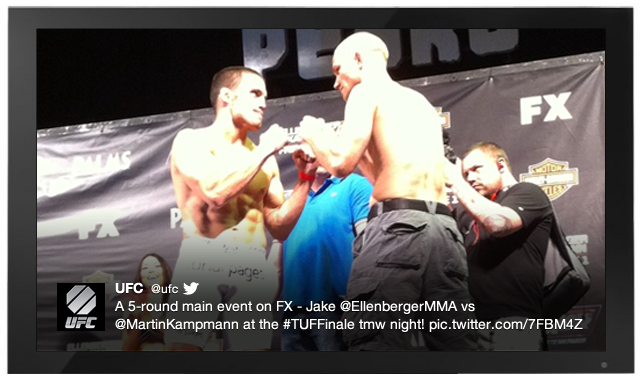Guidelines for using Tweets in broadcast
We welcome and encourage the use of Twitter in broadcast. Our requirements ensure that Twitter users receive attribution for their content, and help provide the best experience for your audience. Here you'll also find suggestions based on what's worked best in previous broadcast integrations, as well as contact info to reach us with any questions.
For information regarding using our brand and trademarks in other settings, as well as content on Twitter, please see our brand and logo resource www.twitter.com/logo.
What we mean by “broadcast"
Broadcast includes but is not limited to: the exhibition, distribution, transmission, reproduction, public performance or public display of Tweets by any and all means of media delivery (all forms of television, radio, satellite, Internet protocols, video, closed-circuit wireless, and electronic sell-through, etc.) whether existing now or developed hereafter. If you’re not sure if your use is covered by these guidelines, get in touch (contact info below).
Use of content
We want to ensure the best experience for those viewing your broadcast and simplify the permissions and licensing process for you. If you follow these guidelines, you do not need to contact Twitter for any additional display or trademark clearances. In some cases, permission from the content creator may still be necessary, as Twitter users retain rights to the content they post.
In all cases, without explicit permission of the original content creator, Twitter content may not be used
- in advertising
- to imply endorsement of any product or service.
Further:
- do not imply sponsorship by, endorsement by, or false association of your production with Twitter.
- do not use Twitter trademarks in the title of your production without first reviewing their use with us.
- make sure you comply with all laws, statutes, ordinances and regulations that are applicable to your provision of content to your audience, including complying with any applicable broadcast standards and requirements.
Graphic display of Tweets, @usernames, or hashtags
Tweets
Requirements:
- Include the Twitter bird www.twitter.com/logo in close proximity to the Tweets for the duration that Tweets appear in your broadcast.
- Include the user’s name and Twitter handle (@username) with each Tweet.
- Use the full text of the Tweet. You may edit or revise Tweet text only as necessary due to technical or medium limitations (e.g., removing hyperlinks).
- Make sure that the Twitter logo or bird icon is a reasonable size in relation to the content. A little taller than a single line of text is a good guideline.
Don’t:
- Delete, obscure, or alter the identification of the user. You may show Tweets in anonymous form in exceptional cases such as concerns over user privacy.
Showing unattributed data in aggregate or visualized form is permitted, but must still include the official Twitter bird.
Images
Requirements:
- Display the Twitter bird when displaying images. The image above demonstrates an appropriate scale.
- Display the Tweet which accompanied the image, including the user’s name and @username. Consider displaying the associated Tweet below the image, as you would a caption.
Don’t:
- Edit a user’s images in any way, including removing or separating any images from the original collection.
@Usernames and #Hashtags
When showing @usernames alone, outside of the context of a Tweet, always include the @ sign and add the Twitter bird to the left.
Always include the # sign in Twitter hashtags, and add the Twitter bird to the left.
Verbal or Voice-Over Versions of Tweets, Usernames, and Hashtags
Tweets
When reading Tweets on air with no graphic display of the Tweet, you do not need to display the Twitter bird but you do need to verbally attribute it to Twitter.
Read the Tweet as originally written, without edits.
Usernames
Make sure to include a reference to Twitter when mentioning Twitter usernames. For example, “Follow us on Twitter, at-username” or “You can follow Lady Gaga on Twitter, at-ladygaga”
Hashtags
Make sure to include a reference to Twitter when mentioning Twitter hashtags. For example, “Use the hashtag ‘election2012’ on Twitter” or “The hashtag for this broadcast on Twitter is bbcaq”.
Additional Information
How to get the most out of using Tweets in your broadcast
Readability improves if the name and @username is displayed with some form of style differentiation from Tweet text (bold, color, size, or other convention) followed on a new line by the full text of the Tweet.
Include user avatars when possible, either to the left of the Tweet or creatively as per your design.
Enhance readability by using distinct animation when showing Tweets, such as fading text.
Questions about using Tweets or the Twitter marks
For questions on these policies, or any question on appropriate use of Tweets or the Twitter marks, please contact us at trademarks [at] twitter.com.
Best Practice Examples
Tweets in the lower third. Ideally, you should animate full, complete Tweets onto the screen and allow them to rest there. We prefer that you don't use continuously scrolling text or a crawl that shows only part of a Tweet at a time.
Full-screen Tweets. Use a different color for the user’s name and @username. We recommend that you animate Tweets onto the screen one at a time. Focus on legibility; don't crowd the screen with Tweets.
Tweets as part of a physical set. Often, showing Tweets on a physical monitor, web wall, or as part of a set design element is your most flexible display option. Make sure the Twitter logo is integrated into that element specifically — not overlaid on the screen in a general way.






